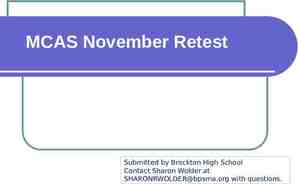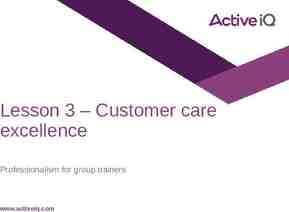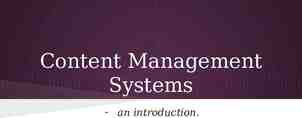Electronic Customer Relationship Management And Supply Chain
21 Slides119.73 KB
Electronic Customer Relationship Management And Supply Chain Management SEM -II Teacher:- S.BHATTACHARYYA Dept. of Commerce T H K Jain College
CRM definitions CRM is mainly Shifting Goals of handling the Customer from T raditional Seller- Oriented Approach to the Customer. It May be defined as the Aligning of the Business Strategy Relating to the Corporate Culture of the Organisation together with the Customer Information And Supporting Information Technology Of the Interaction of the Customer Which will Promote a Mutually Beneficial Relationship Between the Customer And the Enterprise.
CRM is a Business Strategy that Enables Any Business To Achieve the Following Goals: Better Understanding of Customer Better Service Better Way Handling new Contacts Better Relationship with Clients And Customers Better Profit through Customer Satisfaction Decline in Customer management Cost E CRM uses Various Electronic Media to Integrate the Various CustomerRelated Business Process. E CRM is the Application of Internet Based Technologies such as Emails, Websites, And Other Channels to Achieve CRM Objectives. It is Well Structured and Coordinated Process of CRM that Automates the Processes IN Marketing, Sales, and Other Customer Services.
Benefits of ECRM: Improved Customer Relations, Service, Support Matching The Customer Behavior With Suitable Offers Increased Customer Satisfaction And Loyalty Greater Efficiency And Decline of Cost Increased Business Revenue Enable Customization And Personalization of Information Goals of ECRM Business Framework: An Effective E CRM System tracks the Customer History through the Multiple Channels, creates And maintains a systematic database, and Enhances the Customer Relation in three ways: Identification Expansion Maintenance
Features Of ECRM: It is the Integration of CRM And E commerce It is the Integration of Business Process And Technology To Enable Company to Mange Profit And Relationship Effectively It Includes Customer Acquisition, Customer Extension, Customer Retention. Easy to Access All Customer Information Including Enquiry Status And Correspondence to Provide Better Value to Customer. A Set of Integrated Software Application Required Application to Integrate the Various Customer Related Business Processes. Integration of Different Marketing, Online Sales and Other Service Such As Billing, Inventories And Logistics Are Designed As per Needs And Preferences of the Customer through Various Websites.
The Goals of ECRM Business Framework: Identify the Potential Customer Improved Customer satisfaction Improve the Efficiency of Business Expand Customer Base Enhance sales And Support Teams
Identify the Potential Customer: In order to Build Long term relationship, the Primary Goal of E CRM is to Know About Customer Needs. Improved Customer satisfaction: Making the Customer Satisfaction Through Proper Customer Service is Another Important Goals of ECRM. This is Achieved by Devoloping Customer Engagement through Social Networking Sites And Wireless Technology. Improve the Efficiency of Business: Transparent Service, Quick Connection with rapid Customer Service will bring the Development of a strong And Appealing Broad Image For the Business. Expand Customer Base: It Enhances the Customer Relations in Three Ways: Customer Expansion, Customer Acquisition, And Customer Database Maintained. Enhance sales And Support Teams: Talent Management Software, HR Management Software And other Online tools Can Help to Increase the Value of Trained Employees.
Subject CRM ECRM It Follows traditional Methods does not Acknowledge Any use of Information Technology. It uses Information Technology In Implementing Relationship Management Strategy. It Communicates with Customers With Fax, Phone Calls, and Retails Stores. It Communicates with Customers Through Emails, wireless Technology And other PDA Technology. Access facilities Customer can download some Application if they want to view some web Applications. There is no Requirement to download such kind of Applications. System Interface There is No Such Concept of Front Applications. The System has Designed Front Applications With Interface with Back End Applications. Strategy Customer Contacts Maintenance Maintained Cost is Expensive And Time Consuming The System is Situated In various Cost Locations And on Several Servers. Maintained Cost is Minimum And Less Time Consuming. System Focus Various Products And Job Functions Focuses on Customer Need Customizatio Customized Service to Clients And Customers n of Information Are not Possible. Customized Service As per Need of the Clients And Customer are Possible.
Three Phases of ECRM: Phases of ECRM Customer Aquisition Customer Retaintion Customer Expansion Cross selling Process Upselling Process Selecti on
Three Phases of ECRM: Customer Acquisition: With ECRM, Advanced Software Database Are Used to Capture the Profile Data of the Customer of the First Contact. Profile data Includes name, Address, Mobile Number, Email And Social Media Account of the Customer. Benefit: Ability to track the Relationship with Customers and Clients through the Data Analysis. Customer Extension: ECRM Starts With Several Service Intended to Draw out Lenghth of the Typical Customer Relationship, Facilitating the Bigger Revenue. Cross Selling: Selling Related Product to the Prospective Customer When That customer is Looking for the Particular Product. Up Selling: Where the Seller Tries to Give Extra Option to the Buyer With Intention of the making Bigger Sale.
Three Phases of ECRM: Customer Retention: Keeping Regular Contact with Customers Through Email, Offering attractive Incentives, Discounts And Providing Reasonable Price. Selection: Identifying of the Right time of the Prospects And start Before Beginning the Customer Acquisition.
Types of ECRM Types of ECRM Operational Activity Analytical Activity Data Wire House Data Mining Collaborative Activity
Types of ECRM Operational Activity: It is the Internet Based Technologies such As Emails, Websites, And other Modes of Communication In managing Customer Relationship. It is the Integration of the Business Functions and Technology. The Function Included Order management, Sales And Processes, marketing Automation, Customer Service Etc. Analytical Activity: This Activity Includes Two Basic Concept of Management Data Warehousing: It is the Most Reliable And Highly Secured Electronic Storage of Large Amount of Business Information. Data Mining: It is the Process of Selecting the Relevant Information Through Sorting large Amount of Data. It is Used By the Business Houses to Predict customer Buying Behavior And Future Trends Through different Analytical Techniques.
Types of ECRM Collaborative Activity: It is the Communication Center that Provide Different collaborative Service Including Emails, help lines etc. The purpose to Increase Customer satisfaction And Loyalty By Providing Better Quality of the Customer Service.
Functional Component of CRM: Module Based Software: It is Used From Cloud, Virtually, through Mobiles. Business Process: It Includes Panning , management And Control Users Of ECRM: Employees, Workers, Customers etc. Operating System And hardware: The large Operating system for Running CRM Software. People Management: Proper Integration And Co-ordination Between Employees And Customers. Sales Force Automation: To automate Business Task And Sales. Workflow Automation: It Aims to Preventing Loss of Time And Excess Effort.
Strategies for ECRM Solutions: Set A Goal Legislative Compliances Consumer Centric Availability of Information Responsive in Nature Security And Privacy Personalization and Customization Improved Customer Retention
Supply Chain Management Definition: It may be defined as the Design, Planning, Execution,, Control And monitoring of Supply Chain activities With the Objective of Creating Net Value, Building competitive Infrastructure, Leveraging World Wide Logistics, Supply with Demand And Measuring Performance Globally. Importance of SCM: Global Dispersion of Manufacturing And distribution Facilities. Demand for Customized Products. Competitive Pressure Rapid Advances In Information Technology in the Form of EDI
Features Of SCM: Features of SCM Flow of Information Flow of Matarials Processing Customer Requirement Inventory Managemne t Purchase Order Processing Supplier Relationshi Management Flow of Finance WareHouse managemne t
Types of SCM: Pipeline Structure: The Product Goes Through a Series of Production, Assembly Stages in Mass Production or Continued Manufacturing. Late Customization: Products Are Assembled And Customized for Specific Requirement Either in Local Plants or the distribution Process. Divergent Structure: Customization Start in the Starting of the Production Process. Convergent Structure: Sequence of Assembly Task Are Carried out. Private Industrial Network: Collaborative Relationship Between Buyers And Suppliers are Established.
Components of ESCM Planning Advance scheduling And Manufactured Planning: The Detail co Ordination of All manufacturing And Supply Efforts Based on the Customer Order. Demand Forecasting: A Range of Business forecasting Tools in order to Make Decision on Changing Market Situations. Transporation Planning: Flow of Materials And Finished Goods Right At a time and Right Place according to the Planning Schedule. Distribution Planning: It is the Integration of Demand Forecasting Manufacturing And Transportation Planning.
Thank You


























